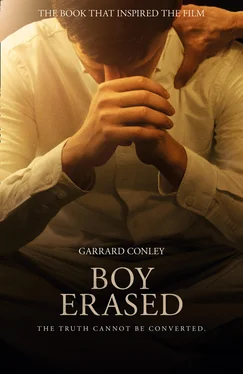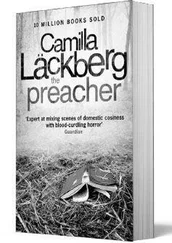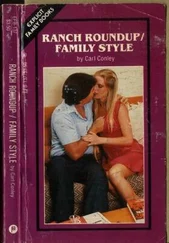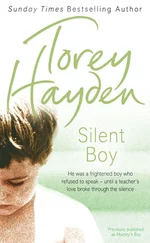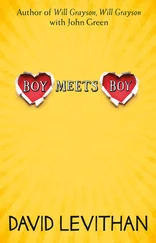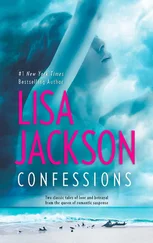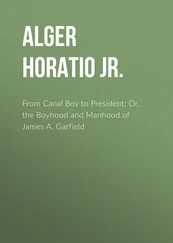“Good answer,” Smid said, writing the words “Family Tree—Genealogy” in large cursive across the top of the board. He turned back to us. “Anything we can add to this?”
I shifted in the padded chair. I’d always felt this nervousness in classes, this need to put an end to the silence following a question no matter how inadequate my answer. I also wanted to impress my fellow group members. I wanted to show them how much I knew, let them see how much smarter I was, how I didn’t make obvious typos, how I didn’t belong here, not really, I was just passing through, I would find my way out of here in no time.
“That was a good guess, S,” Smid said, retrieving a stack of posters from the blond-haired boy. He handed the stack to T, who took one sheet and passed it on. “A genogram shows hereditary patterns and sinful behaviors in our families. It doesn’t trace our genealogy so much as the history behind our present sinful behavior.”
Smid walked back to the board. He pulled off the marker cap with a flourish. First he wrote an A for alcoholism. Then he wrote P for promiscuous. He filled the board with the thick black letters we would use as a key for our genograms. H for homosexuality; D for drugs; $ for gambling; M for mental illness; Ab for abortion; G for gang involvement; Po for pornography. I tried to ignore the lack of parallelism in Smid’s list, a basic style rule I’d picked up in junior high English class. The medium, I told myself, didn’t always have to be perfect. J took one of the poster sheets and passed the stack to me. I could feel his hand tremble as it passed between us. I placed my sheet on the beige Berber carpet at my feet.
Smid turned to face us, clicking the marker cap shut. “Trauma is often linked to generational sin,” he said. “We have to understand where the sin came from in the first place. How it trickled down from father to son, mother to daughter.” I recognized the sentiment from a Bible verse popular in our family’s church—Exodus 20:5.
I the Lord thy God am a jealous God, visiting the iniquity of the fathers upon the children unto the third and forth generation of them that hate me.
The blond-haired boy handed each of us a stack of rubber band–wrapped colored pencils. The veteran members of our group slid from their chairs to begin the daily group project, bringing their posters with them. I quickly followed, my knees already accustomed to hours of kneeling at the tung-oiled altar of our family’s church and asking God to change me. I had spent eighteen years of my life going to church three times a week, heeding the altar call along with my father and the other men, trying to believe in a literal interpretation of the Bible.
“The compulsive patterns of parents influencing children,” Smid continued. “This is the most common root of sexual sin.”
Our color-coded genograms would tell us where everything had begun to go wrong. Trace our genealogy back far enough and we would find, if not the answer to our own sexual sins, then at least the sense of which dead and degenerate limb in our family tree had been responsible.
I scooted my poster over on the carpet so I could be closer to J. S slid her eyes at me as I passed, but I pretended not to notice.
J nudged my ribs with a red pencil, leaving a small checkmark on my white button-down. The weight of my gaze slid down his long ropy arm to where his purple-veined wrist was drawing a wavy red arrow of abuse from his father to his mother.
“I bet that’s it,” he said. His voice was so monotone, it was hard to tell if he was serious or simply regurgitating LIA lingo. I wondered if irony had been a greater part of his personality pre-LIA. I wondered if I would have liked him more outside of this place. “I bet some of that abuse turned me gay. Or it could have been Dad’s D . Or maybe Mom had an Ab before I was born.”
I wondered how anyone could know so much about his family. My clan was tight-lipped; when our past slipped through, it was only in accidental bursts or in code.
“I don’t know where to start,” I said, staring at the blank poster. It was a problem I experienced each time I sat down to write, but I had slowly started getting better at it. Relaxing my thoughts, I could enter my psyche through a side door, sit down cross-legged and examine the hieroglyphs.
“Start with the worst,” J said, smiling, “unless you’re the worst.”
IT WAS HARD to conjure a family tree out of early childhood memories. My father’s life had, from the moment of his calling to be a preacher, filled a vacuum within our family mythology. His importance in our town and community seemed to override everything we knew about ourselves. I was His Son. My mother was His Wife.
People had always seen my father as a devout believer, but at the age of fifty he had taken the next step, stumbling down our church aisle, shaking and crying, kneeling with the entire congregation until our preacher declared that God had called my father to the service. “I was aimless before I found my calling,” my father repeated weekly, standing before pulpits across the state of Arkansas, until my mother and I started to believe him, to clap along with his audience. “I was nothing. But God healed me. He made me whole. Gave me purpose.”
In less than a week, in the middle of the Source program, my mother and I planned to drive from the LIA facility to my father’s ordination as a Missionary Baptist preacher, where we would be asked to stand with him on a brightly lit stage before a church audience of more than two hundred people. The trip was already preapproved by staff and considered integral to my development, a real opportunity to test my devotion to the cause. At the church, my mother and I would be expected to hold hands, smile, to burst into tears at the appropriate moment. Important Baptist Missionary Association of America members would be traveling from every corner of Arkansas to publicly interview the man who many were hinting might be their next Peter, their next Paul, the man whose moral compass might set things to rights for the Baptists, usher in a stronger belief in the Bible’s inerrancy, distill many of the complex issues that had recently begun to plague their association. Issues like divorce, cohabitation, and—most pressing—homosexuality.
“Just think about who you are,” J said, adding the finishing touches to his poster. He was so accustomed to these exercises he could have drawn the symbols with his eyes closed. “Then trace it back to your family history.”
I began by writing the names of my great-grandparents at the top of the poster, followed by my grandparents, then my parents. Next to my parents I added aunts and uncles and all of my cousins. At the very bottom, in slightly smaller print, I added my own name. I followed the genogram key as best I could, placing only one or two sin symbols next to each relative’s name. The grandfather with the alcohol problem: A . The grandmother who divorced him because of the alcohol problem: a line with two diagonal slashes. The two grandparents who’d died one after the other: twin X s. The aunt whose first and second husbands both died in airplane crashes on the way to Saigon, who’d later remarried and divorced: a line with two diagonal slashes. The uncle with the drug and alcohol and gambling problems: D and A and $ , respectively.
As I diagrammed my family tree, coloring in the boxes and arrows and textual symbols, the genogram started to make sense. It provided a sense of security to blame others before me, to assign everyone his or her proper symbol and erase all other characteristics. I could place an H beside my own name, and everything else about me would cease to matter. If I wondered why I was sitting on this carpeted floor with a group of strangers, I could count up the list of familial sins, shrug, and move on to the next activity without asking further questions. All of this confusion about who I was and why my life had led me to this moment could be folded up with my finished genogram, slipped inside a folder, and tucked away in one of LIA’s many filing cabinets.
Читать дальше
